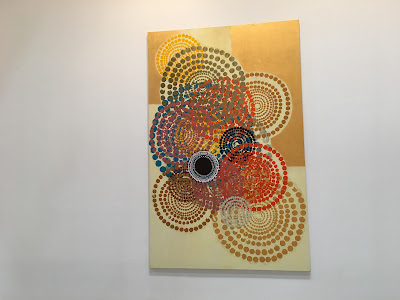Around a month ago, Louise and I joined our friend Stephen Vranch to view the latest special exhibition at Tate St Ives featuring the work of Beatriz Milhazes. 2024 has been a rich year at our local Tate - in May, I published my blog post about the Tate exhibition focusing on the work of Outi Pieski that we had seen in March - see this link here. From Scandinavia to the north and Brazil to the south, the cultural reach of the Tate has been magnificent. We have had such a riot of colour and form to savour, as you saw with Outi Pieski and see again with Beatriz Milhazes.
I love the insight in Milhazes' words, referenced in the Tate show:
My context has been surrounded by forests, mountains and coastal experiences; the development of a 'tropical' way of thinking. In St Ives it is very special for me to experience the same ocean as in Rio de Janeiro. Same water, different cultures, but in the end it is all about life.'
Her paintings and collages draw on a range of sources - from the natural and urban landscapes of Brazil to the histories of art and architecture.
Born in Rio de Janeiro in 1960, Milhazes rose to prominence in the 1980s as part of an 80s art movement that took a new direction away from the austere abstractions of previous decades. Artists within this new paradigm embraced painting as a medium for energy and expression. Milhazes has
carved a reputation for vibrant, large-scale abstract canvases that delight in exploring tensions between form and colour.The title of the exhibition is 'Maresias', a reference to the salty sea breeze that is part of Milhazes' daily experience in the coastal city of her birth. Her works have carried titles since the late 1980s; they are poetic and their meaning cannot always translate into English. Let the images speak for themselves.
In 2003, Milhazes returned to making collages with found materials including sweet wrappers, branded packaging, tissues, and hologrammed and silkscreened papers. She sources these materials from her everyday life and travels, and so the collages function almost as a personal journal. She cuts them into shapes inspired by diverse influences in her life such as tropical fauna or architectural details of Baroque buildings. Milhazes is fascinated by the hybrid nature of everyday life in Brazil.
She has long used natural forms in her work although the intent has not been to imitate nature, rather to explore how nature has been portrayed in the decorative and applied arts. The flower becomes a focus as part of a patterned fabric; a wave has its inspiration in a detail from mid-century architecture. However, from 2008 Milhazes work begins to show the direct influence of nature, especially Rio de Janeiro's Copacabana beach. She has become absorbed in exploring the cycles of renewal in the natural world, a focus that is reflected in her use of circles and in motifs drawn from rivers, oceans, petals and branches. For Milazes, her ever-present circles are 'the core of spirituality - they are connected to the breath and vitality of the forests, flowers, leaves, animal shapes, the power of the waves, water, oceans, the Earth's rotation, the Sun, the Moon, day, night, sky, light. It has to do with the order of Nature. It's both alive and structured - and that's what I try to show in my work.'









No comments:
Post a Comment